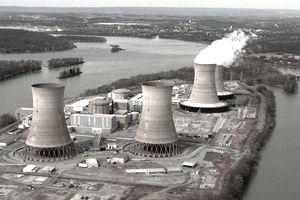There are certain dates that mark significant, sometimes life-changing, events that we all seem to be able to recall where we were, possibility we might have a good idea of what we were doing, and maybe even what we were eating when we heard that day’s big news. For lots of people, March 28th is one of those days. Today marks the 40th Anniversary of the Three Mile Island accident which resulted in the partial melt-down of one the two nuclear reactors on this site.
Located in the middle of the Susquehanna River a few miles south of Harrisburg, this nuclear power station and the early-morning events March 28, 1979, put central Pennsylvania on the map and in the minds of people worldwide. For most of us who were living at the time and who were focusing on what was going on at Three Mile Island, this accident had much wider consequences.
While the overall Three Mile Island incident was rated as a 5 on the 7-point International Nuclear Event Scale, many people, me included, believed we witnessed evidence of the failure of what had been cast as a ‘fail-safe’ system. In this case, it was the breakdown of a human-computer-machine interaction that did not and could not perform “as advertised.”
Mechanically, we were being told that…“failures in the plant’s non-nuclear secondary system, followed by a stuck-open pilot-operated relief valve in the primary system, may have allowed large amounts of nuclear reactor coolant to escape. These mechanical failures were compounded by the initial failure of plant operators to recognize the situation as a loss-of-coolant accident due to inadequate training and human factors, such as human-computer interaction design oversights relating to ambiguous control room indicators in the power plant's user interface.”
That was just a fancy way of fumbling through a gobbledygook explanation which only ended up creating more and more confusion. In the end, these public utterances resulted in the near-catastrophic loss of confidence in most of our public officials among those of us who lived in TMI’s vicinity. What we learned was words like ‘may’ and ‘should’ just make a situation worse for people who are desperate for real, solid answers.
What none of us could have predicted back in 1979 was the fairly-bleak future that this whole event was about to cause for our nation’s entire domestic nuclear energy industry.
Today, 40 years later, one of the hottest debates in the halls of government down in Harrisburg is what and how much, if any, the taxpayers of Pennsylvania should pay to keep nuclear as part of our state’s energy portfolio. While our Chamber mentions not even a word in our 2019 Legislative Agenda about this topic, it’s sure to be hotly debated issue this spring and will likely play a major role in the on-time passage of the state budget early this summer.

